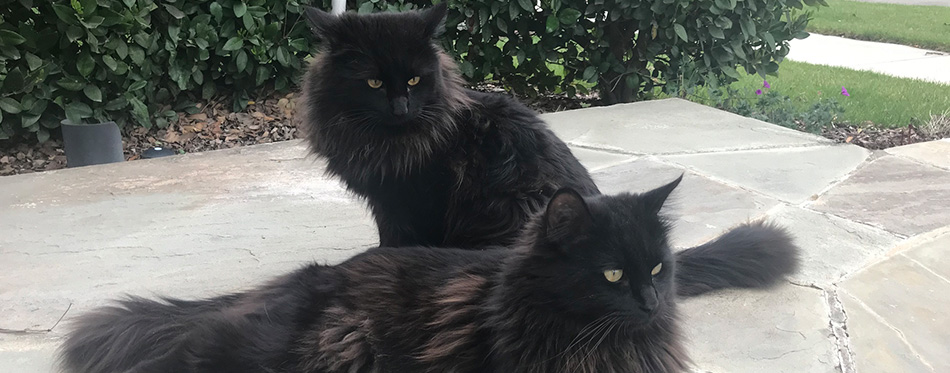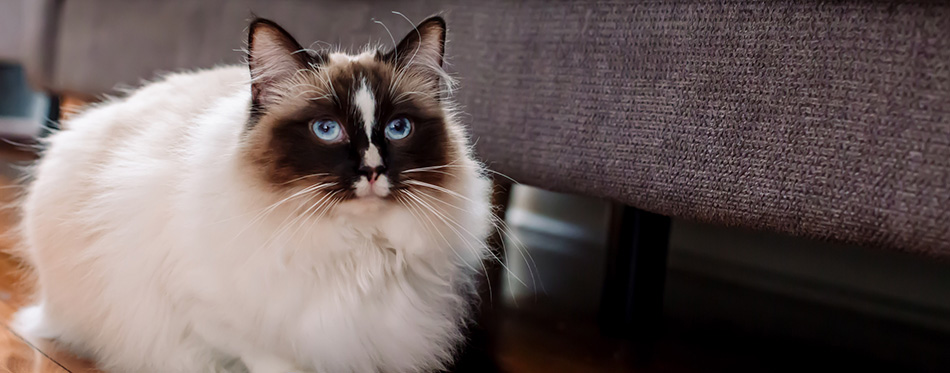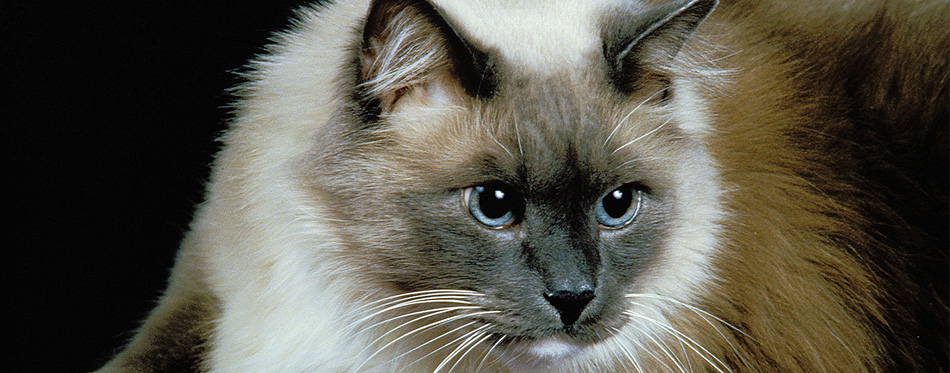It is easy to see why the Cat Fanciers’ Association named the Ragdoll cat as the most popular feline breed in 2018. With its large and beautiful eyes made more elegant by its plush coat, what is not to love about this large kitty? And oh, it also has one of the most adorable temperaments in the feline world. If you are a staunch lover of dogs, you will also fall in love with this kitty. They love to snuggle up to their human companions and will never extend their razor-sharp claws when picked up. As a matter of fact, they go on a docile, ragdoll-like pose and will relish every second they have in your arms. They are sweet, well-behaved, and very affectionate kitties. As popular as Ragdoll cats are, they require special care. Let us find out if this feline wonder deserves you to be its pet parent or guardian.
History of the Ragdoll
While the Ragdoll is indeed a growing favorite among cat fanciers all over the world, it does have a troubled history. It is not so much as to how this lovable kitty came to be, but more because of the controversy between its original breeder and the growing Ragdoll owner community.
Ann Baker reserves credit for creating the very first Ragdoll cat sometime in the 1960s. However, some breed historians dispute this claim, saying that the very first Ragdoll cats may have been the kittens of one of the cats of Baker’s neighbors, the Pennels.
The Pennels had a white Angora named Josephine. Like most cats of the yesteryears, Josephine never stayed indoors very long. As such, it “interacted” with male cats of all sorts from the neighborhood. Several of Josephine’s kittens produced highly uncharacteristic traits for a cat. Many of these kittens displayed docile and placid temperaments. Every time these kittens get picked up by someone, they also go limp. This is very uncharacteristic, since cats are known to stiffen their bodies whenever they get picked up or carried by a person.
Ann Baker recognized the potential of these kittens. She knew that they are very unique. She also knew that there are potential cat owners who would like to have a cat that has a dog-like temperament. Hence, Baker borrowed Josephine from the Pennels. She also borrowed the Pennels’ male Birman.
Now, this is another controversy. Both Josephine and the supposed male Birman are non-pedigreed. It is possible that Josephine may only look like a white Angora and the male Birman may only look like such. As such, there is no telling what feline breed is present in the Ragdoll cat. A later study by the Ragdoll Historical Society did confirm Josephine’s breed as that of an Angora.
The mating of Josephine and the Birman cat produced two male kittens. One of these had an all-black coat, which Baker named Blackie. This kitten looked like a Burmese cat. The other male kitten was a seal point with white paws. She named it Daddy Warbucks.
Baker then mated Blackie and Daddy Warbucks back to Josephine. The mating between Josephine and Daddy Warbucks produced a bi-color kitten Baker named Fugianna. Josephine and Blackie produced a kitten with dark-brown coat which Baker named Buckwheat. Baker retained Josephine, Fugianna, Daddy Warbucks, and Buckwheat to form the core of her Ragdoll breeding program.
In 1965, Baker mated Daddy Warbucks and Buckwheat to produce 4 kittens. Two of these had solid colors while the other two were colorpoints. Baker named the two colorpoints as Kyoto and Tiki. The solid-colored kittens Baker named as Gueber and Mitts.
A year later, in December of 1966, Baker registered four of her cats as the world’s very first Ragdolls. These included Daddy Warbucks, Fugianna, Tiki, and Kyoto. All four were colorpoints. This was deliberate since Baker only wanted to produce a cat that had a very specific coat color characteristic.

One of the first people who were able to buy Ragdoll kittens from Baker were Laura and Denny Dayton. The Daytons purchased two Ragdolls from Baker and named them Buddy and Rosie. The Daytons tried to convince Baker to promote the breed by creating an organization of cat breeders. Baker objected to the idea and this is where one of the greatest controversies of the breed lies.
The opinion is that Baker was afraid of relinquishing control of her thriving business. Creating an organization of Ragdoll breeders meant she will have to share the resources, credit, and “income” from the breed. In other words, there is widespread belief that Baker will lose her monopoly of the Ragdoll.
Baker, nevertheless, relented. In 1971, she established the International Ragdoll Cat Association. While this is a positive move, it was not to be. It only cemented further Baker’s hold of the Ragdoll breed. Baker designed the IRCA not as a breeders’ organization, but more as a franchising platform. The only way one can breed Ragdolls is if they become a franchisee of the IRCA.
For obvious reasons, the Daytons and other Ragdoll owners do not want anything to do with Baker’s business-oriented approach to breeding. The group formed a different organization dedicated to promoting and advancing the wonderful characteristics of the breed. The organization encouraged Ragdoll owners and breeders to continue developing the breed.
In 1977, the growing family of Ragdoll cat owners established their very own organization – the Ragdoll Society. They reorganized in 1978, establishing the Ragdoll Fanciers’ Club. To formalize the club’s growing importance, the group affiliated themselves with one of the oldest cat breeders’ organization, the Cat Fanciers’ Federation.
Over the years, the RFC continued to flourish. The Ragdoll Fanciers’ Cub International is now the official organization of Ragdoll owners and breeders. The RFCI has the official recognition of major cat registries like the Federation Internationale Feline and the Cat Fanciers’ Association.
Quick Facts about the Ragdoll Kitty
Ann Baker may have created the first Ragdoll, but everyone knows how controversial her intentions were right from the beginning. However, the work of the Daytons and the other pioneering members of the Ragdoll Fanciers’ Club provided the standards of the Ragdoll as a breed.
- Ragdoll cats got their name from their uncanny tendency to go limp whenever someone picks them up and cradles them in the arms. They assume the position of a young child’s rag doll being held by the child in her arms.
- Ragdolls are large cats. Males can be as heavy as 20 lbs and never weigh less than 15 lbs. Females can weigh between 8 and 15 lbs, although it is not uncommon that they can be heavier.
- Ragdoll kittens always come in white. It would take about 2 to 3 years before they achieve their full color. However, the prevailing coat pattern and color point will already start to show as the kitten reaches 10 days old.
- This breed of cat can come in 3 types of color patterns: colorpoint, mitted, and bi-color.
- Colorpoint Ragdolls can come in lynx, tortoiseshell, and solid colorpoints. It is also possible that they have a combination of tortoiseshell and lynx.
- Bi-color Ragdolls come in a combination of white and solid color. The color is evenly distributed. There is a subtype of this pattern called Van. The cat has spots of darker color on its ears, the top of the cat’s mask, and the tail.
- Mitted Ragdolls have a white chin, belly, and paws.
- Majority of the colorpoints are seal. However, there are also kitties that come in lilac, blue, cream, chocolate, and red. Lilac colorpoints are very rare.
- One of the striking features of the cat is its large, beautiful blue eyes.
- They have a plush coat. However, they do not have a dense undercoat. These cats only have long guard hairs.
- Because of the unique characteristics of its coat, Ragdolls have less risk of matting and less incidence of shedding. This makes them very easy to groom and friendly to people with allergies, too.
- Ragdoll cats have a lifespan of 12 to 17 years. It is one of the longest-living cats in the world, although the record is 38 years for a domestic cat.
- In 2017, the Ragdoll ranked number 2 in the CFA’s most popular breed. A year later, it is now the feline world’s top cat.

Things You Should Know
One of the best characteristics of the Ragdoll cat is its docile, placid, and very gentle temperament. It has all the beautiful qualities of cats and the sociable nature of dogs. First-time Ragdoll owners can get captivated by the cat’s stunning looks. And as they spend more time with this kitty, the fondness for the breed grows. If you think you also want to be the parent of such a lovely and adorable pet, then you’ve got to understand their basic needs.
Health
While Ragdolls are one of those cat breeds that can live up to 17 years, there is an interesting study in Scandinavia showing they have one of the lowest survival rates among cats. The majority of Ragdolls die of problems in the urinary system. It is not known, however, if this is particular only to the region or is a worldwide occurrence.
Ragdolls are not immune to hypertrophic cardiomyopathy. In this disease, the walls of the heart begin to thicken. This can compromise the heart’s ability to pump blood. When the heart’s pumping ability gets undermined, the different organs of the Ragdoll’s body may not be able to receive oxygen and nutrients. At the same time, the heart will not be able to remove metabolic wastes such as carbon dioxide.
Hypertrophic cardiomyopathy is very common among cats regardless of their breed. If both parents of the Ragdoll have this disease, the kitten may not last that long. Many such cats can die at an early age of 3 years. If only one Ragdoll parent has the disease, the impact on the kitten is less severe. It may also be able to live to the fullest.
As such, it is critical to ascertain from the Ragdoll breeder the HCM status of the cat’s parents. If both Ragdoll parents do not have the HCM gene, then the Ragdoll kitten can grow up as a healthy adult cat.
Ragdolls are not only at risk of developing HCM; they can also have feline viral rhinotracheitis, intestinal parasitism, pneumonitis, and feline distemper. Cystitis or inflammation of the urinary bladder is also quite common. Like all cats, Ragdolls are also at risk of infestation of mites, fleas, and intestinal parasites.
Feeding
Laura Dayton described the “ideal” diet for the “lovable” Ragdoll. Dayton recommends either Feline Zu-Preem or C/D Feline Prescription Diet. If these are not available, then the Ragdoll can have home-cooked meal. A sample recipe includes 1 part heart, 1 part kidney, 2 parts lean sirloin, ½ part liver, and ½ part beef melt. Pet parents should grind the mixture and bake it as a meatloaf.
Dayton’s Ragdoll diet recommendation underscores what many cat parents firmly believe. Cats thrive best on a diet that is rich in animal proteins and healthy fats. Felines may also need carbs to help supply readily-available energy. However, the proportion of carbs in their diet should never be greater than that of proteins.
There is another reason why Ragdolls should never have too much carbs. Its energy level is not that high. If you have such a thing as a lap cat, then the Ragdoll would be one of them. Giving it too many carbohydrates can lead to feline obesity, owing to the low-energy level of this cat.
When it comes to proteins, only animal-based proteins will do. Ragdolls are always at risk for heart problems like HCM. Feeding plant-based proteins can deprive it of Taurine, an amino acid necessary for optimum heart health. You may think Taurine supplementation can address the issue. But this is quite different from real Taurine sourced from animal proteins.
Hence, make sure to give the Ragdoll only high-quality, meat-based proteins. Your best bet is a high-quality wet cat food.
For more guides on choosing the right cat food, you may wish to check out our reviews of the best dry cat food, senior cat food, hypoallergenic cat food, cat food for hairballs and cat food for sensitive stomachs.
Care
Ragdolls require frequent visits to the veterinarian. It needs to get its recommended vaccine shots to help protect it against highly-preventable feline diseases. While vaccination does not make your cat immune from all types of diseases, it sure can protect it from some of the more serious ones.
Cleaning the litter box is a must every week. Having an extra litter box can help facilitate easier potty training for the Ragdoll. Getting scratching posts, cat bed, and interactive cat toys are also important in ensuring optimum health for the Ragdoll.
Ragdolls are large kitties. They need exercise so they don’t turn into obese or overweight cats. These cats are also trainable. Unlike other cats, pet parents can teach a Ragdoll to walk on a leash.
A more important part of their care is to keep them indoors. There are many hazards outdoors that can undermine the health and safety of the Ragdoll. From stray cats to other animals, the Ragdoll can get into a fight. Owing to its peace-loving nature, the fight may not end well for the Ragdoll. These cats are also expensive as they are quite rare. Hence, you have better keep them indoors if you don’t want them falling into the wrong hands.
Grooming
Grooming this cat is pure joy. Its rabbit-like fur is so easy to comb. It doesn’t tangle or form mats. That doesn’t mean you are not going to comb it anymore. It is still imperative that you do. This will help improve blood flow to its skin and contribute to better health for its coat and skin. Do not brush its coat as it can make it frizzy. Instead, stainless steel comb is ideal.
The cat’s teeth need everyday brushing. If this is not possible, then twice a week dental care is enough. Its ears also need inspection and cleaning at least once a week. The nails require clipping every 3 to 4 weeks.
For more help on cat grooming, you may wish to read our guides on the best cat ear cleaners, cat nail clippers, brushes for cats, cat grooming gloves and cat shampoos.

Temperament
Ragdolls have many dog-like qualities. They are amiable to both children and other pets. If you happen to have a multi-pet household, these kitties can live in harmony with dogs. This is if your dog is also amiable to cats. This breed of cat is also very affectionate of its family. It is like the shadow that remains glued to the feet of its master.
The feline breed loves to cuddle. It likes getting picked up from its nook and carried in the arms of its loved ones. It wants nothing more than feeling the warm affection of its owners. Their placid nature makes them perfect subjects for photo shoots. Dress them up in fancy clothes and they’d be glad to pose for you.
Ragdolls are not athletic. They prefer the comfort and security of the ground or the floor. You won’t see them climbing or jumping from one structure to another. Ragdolls also have a soft, musical voice. It is an adorable cat that has all the fine, sociable qualities of a dog in a large cat’s body.
The Ragdoll is a cat that is fast becoming the darling of the cat-loving world. It is a beautiful cat with a golden heart, made more stunning by its gentle and friendly nature.
Sources:
- Ragdoll Cat – PetMD
- About the Ragdoll – CFA

